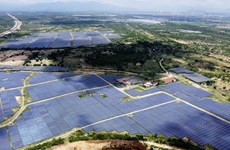Veteran devotes life to building foot bridges
When asked how many bridges had been built as a result of his fund-raising efforts, farmer Mai Van Vo, a former war veteran, had no idea.
 Mai Văn Vo has been seeking funds to replace "cau khi" (foot bridges) with cement bridges (Photo thanhnien.vn)
Mai Văn Vo has been seeking funds to replace "cau khi" (foot bridges) with cement bridges (Photo thanhnien.vn)HCM City (VNS/VNA) - When asked how
many bridges had been built as a result of his fund-raising efforts, farmer Mai
Van Vo, a former war veteran, had no idea.
Decades ago, the 71-year-old, who lives in Gia Lai town in the Mekong Delta province of Bac Lieu, began seeking funds to replace cau khi (foot bridges) with cement bridges.
Although the number of new bridges exceeds 300, Vo said he had never bothered to count.
“I did this for local people because I wanted them to have better transportation,” he said.
Working hard and never boasting about their contributions to society appears to be part of the character of many former soldiers.
Like many farmers living in the Mekong Delta, Vo is not well-off but has a generous nature.
Recalling the first cement bridge that was built, he said: “I’m a member of the Veterans Association of Dong Hai district in the province. More than 10 years ago, we started the programme of replacing foot bridges in response to the provincial plan of studying and following Ho Chi Minh’s ideology, morality and lifestyle.”
Vo said the initial work was difficult as many people thought “it was the Government’s responsibility” and few people wanted to donate money.
However, Vo was determined to continue raising funds, seeing local schoolchildren and residents struggle every day as they crossed the foot bridges.
“Dong Hai district has more canals than any area in the province. Some island communes had no roads or even foot bridges at the time. They had to use small boats as their daily vehicles,” he said.
Pursuing his plan, Vo identified sites to build bridges and then set up a budget, while also encouraging families to persuade their local authorities to contribute money.
With his prestigious position of being a war veteran and party secretary of his commune, he explained to local residents how important the bridges were and the benefits they would receive.
He told them that Dong Hai district had many bridges that needed to be replaced and that they could not wait for the Government to do all the work.
As a result, he began to see a more positive response.
Poor residents were willing to pitch in between 100,000 VND and 200,000 VND, and those with better incomes contributed from 2 million VND (90 USD) to 5 million VND (220 USD). People who could not offer money took part in building the bridges.
The first cement bridge was built in An Trach commune in Dong Hai district.
“When the bridge was completed, people were so happy.” Vo said. “I remember that the bridge was about 60-70m wide and it was finished in a month.”
With one bridge project completed, Vo had the confidence to pursue his goal of replacing all the foot bridges.
Along with calling for contributions from locals, Vo met sponsors in HCM City who donated funds for the bridge project.
Today, there are no foot bridges in Dong Hai district.
Thanks to the new bridges, people’s living standards have improved, with many shops serving residents who live near the bridges.
The district’s Veterans Association said that since 2011, Vo had called for 14 billion VND to build 337 bridges. The cost for each bridge ranged from 30 million VND (1,300 USD) to 200 million VND (8,000 USD).
Vo also called for money to repair eight roads with a total length of 10,000 metres.
Now older, Vo has decided to leave the job of mobilising capital for new bridges to a new generation, who, he hopes, will devote their lives to help farmers have a better life.-VNA
Decades ago, the 71-year-old, who lives in Gia Lai town in the Mekong Delta province of Bac Lieu, began seeking funds to replace cau khi (foot bridges) with cement bridges.
Although the number of new bridges exceeds 300, Vo said he had never bothered to count.
“I did this for local people because I wanted them to have better transportation,” he said.
Working hard and never boasting about their contributions to society appears to be part of the character of many former soldiers.
Like many farmers living in the Mekong Delta, Vo is not well-off but has a generous nature.
Recalling the first cement bridge that was built, he said: “I’m a member of the Veterans Association of Dong Hai district in the province. More than 10 years ago, we started the programme of replacing foot bridges in response to the provincial plan of studying and following Ho Chi Minh’s ideology, morality and lifestyle.”
Vo said the initial work was difficult as many people thought “it was the Government’s responsibility” and few people wanted to donate money.
However, Vo was determined to continue raising funds, seeing local schoolchildren and residents struggle every day as they crossed the foot bridges.
“Dong Hai district has more canals than any area in the province. Some island communes had no roads or even foot bridges at the time. They had to use small boats as their daily vehicles,” he said.
Pursuing his plan, Vo identified sites to build bridges and then set up a budget, while also encouraging families to persuade their local authorities to contribute money.
With his prestigious position of being a war veteran and party secretary of his commune, he explained to local residents how important the bridges were and the benefits they would receive.
He told them that Dong Hai district had many bridges that needed to be replaced and that they could not wait for the Government to do all the work.
As a result, he began to see a more positive response.
Poor residents were willing to pitch in between 100,000 VND and 200,000 VND, and those with better incomes contributed from 2 million VND (90 USD) to 5 million VND (220 USD). People who could not offer money took part in building the bridges.
The first cement bridge was built in An Trach commune in Dong Hai district.
“When the bridge was completed, people were so happy.” Vo said. “I remember that the bridge was about 60-70m wide and it was finished in a month.”
With one bridge project completed, Vo had the confidence to pursue his goal of replacing all the foot bridges.
Along with calling for contributions from locals, Vo met sponsors in HCM City who donated funds for the bridge project.
Today, there are no foot bridges in Dong Hai district.
Thanks to the new bridges, people’s living standards have improved, with many shops serving residents who live near the bridges.
The district’s Veterans Association said that since 2011, Vo had called for 14 billion VND to build 337 bridges. The cost for each bridge ranged from 30 million VND (1,300 USD) to 200 million VND (8,000 USD).
Vo also called for money to repair eight roads with a total length of 10,000 metres.
Now older, Vo has decided to leave the job of mobilising capital for new bridges to a new generation, who, he hopes, will devote their lives to help farmers have a better life.-VNA













